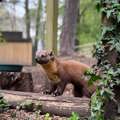European Pine Marten

General information
This stunning, elusive animal has chestnut brown fur and a creamy throat bib. The Pine Marten’s main diet are small mammals and birds but they will also forage for seasonal fruits and berries. It is believed that due to the pine marten preying on grey squirrels and other invasive rodent species, they have a positive impact on the threatened native red squirrel.
They are a solitary territorial mustelid marking their range with faeces (scats). Breeding season will be throughout July and August, which is then followed by delayed implantation of the egg. After 7 months, the fertilised egg will then begin to develop over a 30 to 35 day gestation period. Pine Martens will have between 3 to 5 kits in a litter, although the mother only has 4 teats to feed. By 6 months the kits will leave their mother but will often stay in her territory for another few months.
After much persecution and habitat loss leading to fragmentation, the Pine Marten is slowly increasing its range and there have been some sightings in the north of England and Wales but also the New Forest National Park!

Latin name - Martes martes
Class - Mammalia
Order - Carnivora
Family - Mustelidae
IUCN Status - Least concern
Habitat - Woodlands, forests and adjacent grasslands
Distribution - Northern Europe including United Kingdom, Europe, Asia and Russia
Average Lifespan
3 to 4 years in the wild
Threats
Hunted for its fur, loss of habitat, persecution as a potential predator of livestock and direct and indirect poisoning.
Fun Fact
They are so agile that they can jump distances of up to 20 ft between the trees and descend head first easily due to their sharp claws and hind legs that can swivel around 180 degrees – quick enough to catch a squirrel!
Our Residents
There are very few collections around the UK that keep Pine Martens. They are difficult to breed in captivity and after many unsuccessful years with one pair, we now have a successful pair, Hamish and Rolo.
Hamish is a male wild rescue who came to us from the Scottish Highlands with his two sisters, Iona & Morag, in 2012. Rolo is a female who was captive bred at Wildwood Trust, in Kent, in 2012.
Rolo & Hamish have successfully produced 4 litters of 3 kits in 2015, 2017, 2019 & 2022. All the kits have either moved on to other wildlife parks or zoos to join the breeding programmes themselves, or have been released into the wild through release programmes in Scotland and Wales.
In the summer of 2024 we moved both Rolo and Hamish into their own brand new purpose built enclosures, which had been designed and constructed by our maintenance team and managing director Ed Heap!

Sign up to our newsletter
Join our mailing list in order to keep up to date with park news and special offers.




